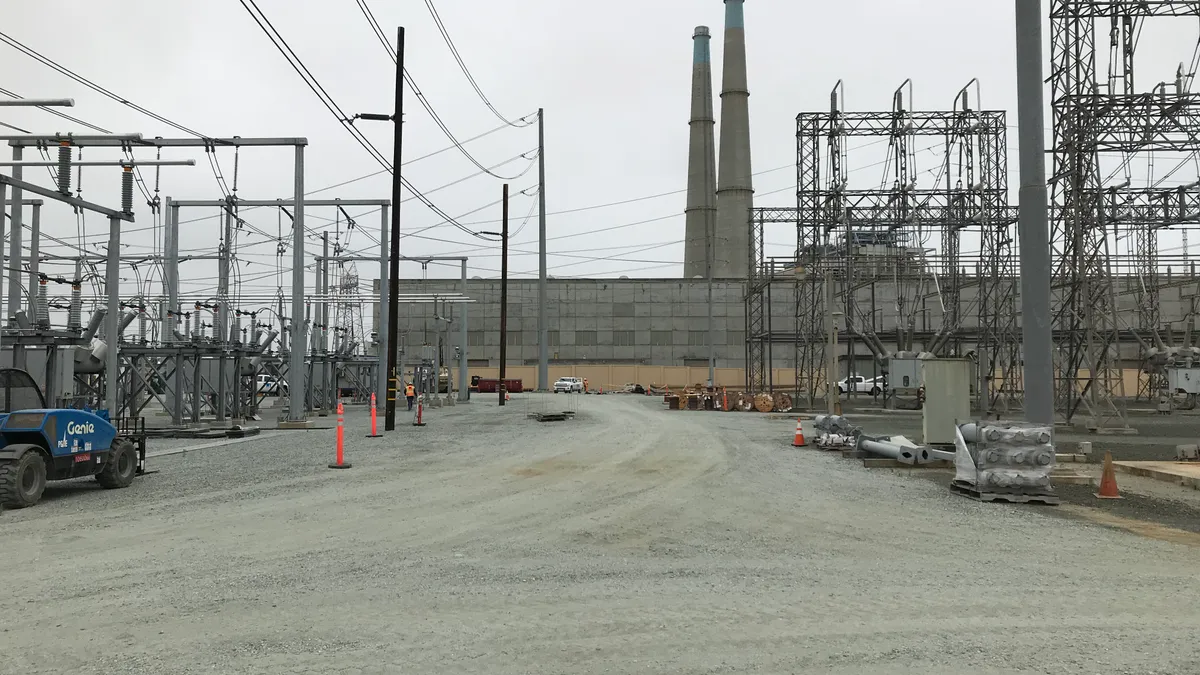It may not be smooth sailing for Pacific Gas and Electric's landmark energy storage projects.
Totaling 567 MW, 2,270 MWh, the four projects were hailed as the largest battery storage investment ever proposed when PG&E submitted them for approval at the California Public Utilities Commission (CPUC) in late June. However, comments opposing the projects could slow down their approval and implementation.
Already, the state's Office of Ratepayer Advocates (ORA) and the Direct Access Customer Coalition (DACC) have filed comments opposing the projects, prompting the CPUC to extend the approval process by at least 120 days. The comments raise questions about whether or not the energy storage projects are needed and whether PG&E's proposal conforms to the commission's directives.
The recently-filed comments have had very little public scrutiny, as they were only sent to the relevant parties and have not been posted on the CPUC website.
The cost of reliability
In their comments, the ORA, which is part of the CPUC, argues that the energy storage projects are not needed because the deficiency they are designed to fill will be met with new and planned transmission projects. The ORA claims the projects do not comply with CPUC resolution (E-4909) that authorized PG&E to issue a solicitation for the projects.
The resolution is designed to alleviate the need for an out-of-market contract for Calpine's Metcalf Energy Center, a 564-MW gas-fired plant in San Jose. Calpine had told the California ISO that it would have to take the plant out of service because it was uneconomic, but the ISO determined the plant is needed, granting a reliability must run (RMR) contract.
In the resolution authorizing the storage projects, the CPUC expressed its concerns about the impact the RMR contracts would have on ratepayers and the lack of competition in the RMR process that can lead to "market distortions and unjust rates for power."
The commission ordered PG&E to enter into energy storage contracts at "reasonable cost to ratepayers" and to take into consideration the cost and value and the results of previous, similar solicitations. But the ORA argues PG&E did not meet the CPUC's requirements because the utility did not provide "analysis or explain how the cost of the four energy storage projects are reasonable taking into consideration the cost of the Metcalf RMR contract." Nor did PG&E compare the four contracts to previous energy storage solicitations, the ORA said.
Costs of the energy storage projects are redacted in the public comments. The comments are not available online because they are not filed with the commission. They are only sent to the relevant parties. By law, the utility is required to respond to comments. The CPUC's industry division will gather all comments and responses and prepares a draft resolution with its recommendation. The commission then votes on the draft resolution.
The protests to the proposed storage projects should be rejected because "they inaccurately characterize the PUC's resolution and rely upon an unreasonably narrow reading of certain ordering paragraphs in the resolution that is inconsistent with the remainder of the resolution," PG&E spokesman Paul Doherty, told Utility Dive via email.
While the transmission projects that are under way would mitigate the original capacity deficiency that prompted an RMR contract for Calpine's Metcalf plant, that solution, without added capacity, is short-lived, Doherty said.
A combination of load growth and the highly constrained resources mean that the capacity deficiencies would likely reemerge in the 2019 to 2022 timeframe. That could happen if either Metcalf or another gas-fired generator in the South Bay-Moss Landing sub-area threatened retirement and forced an RMR contract.
Furthermore, the critics of the proposed energy storage projects seek to "unreasonably limit the Commission's ability to ensure the long-term reliability of the grid and prevent a cost-effective solution to address the capacity needs in the constrained South Bay-Moss landing local sub area, Doherty said.
"PG&E provides no evidence that it coordinated with the CAISO or obtained the CAISO's agreement that the procured resources would be effective in avoiding an RMR contract before submitting its advice letter."

Direct Access Customer Coalition
CPUC Comment
Filling the need
Costs aside, ORA's main argument is that the energy storage units are not needed. The agency notes that in its advice letter to the CPUC, PG&E says the deficiency that led the RMR contract for Calpine was eliminated by the $14 million transmission upgrade the California ISO approved as part of its 2017-2018 transmission plan for the South Bay-Moss Landing sub-area where the Metcalf plant is located.
The ORA also says that PG&E "improperly attempts to support its procurement of the four energy storage projects by stating it may need resources in 2023" even though the CPUC resolution confined need for the storage project to the 2019-2022 time frame.
The ORA also argues that PG&E failed to provide any analysis demonstrating that the energy storage projects would be charged from renewable energy resources and, therefore, there is not enough information to assess whether or not the storage projects would decrease greenhouse gas emissions.
The DACC makes similar arguments to the ORA, contending that PG&E did not comply with the CPUC's resolution when it continued its solicitation for energy storage resources even though those resources were no longer needed because new transmission upgrades that will "fully address the deficiencies that gave rise to the RMR contracts" will be in place by February 2019.
DACC also argues that PG&E failed to provide "any analysis of the costs and terms of the four storage contracts compared to the RMR contract." The group noted that the yearly cost for just one of the four projects — Tesla is building a 182.5 MW, 730 MWh project that PG&E will own — is "comparable to one year of the RMR contract." In addition, DACC pointed out that the RMR contract is short-term while the energy storage contracts range from 10 to 20 years in length.
DACC, like the ORA, also argues that PG&E did not follow the CPUC's directive regarding consulting with the CAISO on the energy storage projects. "PG&E provides no evidence that it coordinated with the CAISO or obtained the CAISO's agreement that the procured resources would be effective in avoiding an RMR contract before submitting its advice letter," the filing says.
Competitive issues
Comments filed earlier this year by the Western Power Trading Forum (WPTF) and the Independent Energy Producers Association (IEPA) focused on what they saw as a lack of competition in the CPUC's process.
In its filing, the IEPA pointed to a deeper problem in California's power market in the design of California's resource adequacy (RA) market. As it stands, the RA framework is too short (one year) while lacking transparency, and does not address near term (one to five years) market needs. The trade group also notes that PG&E's proposal is outside the normal long-term procurement process and recommends that the CPUC direct PG&E to conduct a fresh solicitation to meet the deficiencies identified in its proposal but make it an all-source solicitation. PG&E's solicitation excluded proposals for gas-fired generation.
The IEPA also asks the CPUC to direct PG&E to make its bid selection evaluation and criteria more transparent.
In a similar vein, the WPTF said that while the CPUC's resolution "purports to better preserve competitive procurement, its ad hoc approach is no more consistent with competitive procurement than is the issuance of RMR contracts." The trade group said that the resolution, if approved, would set a "poor precedent that undercuts the Commission's efforts to have a comprehensive approach to procurement, resource adequacy and system reliability."
The WPTF says the CPUC's resolution is "completely misguided" and should be rejected "in its entirety." Directing PG&E to engage in "an ill designed solicitation solely because the RA program is broken ignores the proper and obvious solution: the Commission should fix the manifest flaws in the current RA program," the group said.
DACC, for its part, is asking the CPUC to reject PG&E's advice letter because it is not compliant with the commission's resolution. The ORA goes a step further. The ratepayer advocate also is asking the CPUC to deny PG&E's advice letter, but the agency also argues that an advice letter is not the proper procedure for such a matter. The advice letter mechanism was set up for issues that are controversial and involve important policy questions. But the four energy storage projects raise "important and contentious questions regarding their reliability and cost impacts," the ORA said, concluding that any further consideration of the issue, if the CPUC deems it necessary, should happen in a formal proceeding that is open to public comment.
In defense of PG&E's storage project, the California Energy Storage Association (CESA), in a recent filing, took up PG&E's argument that the Metcalf plant is only one of several thermal power plants facing the risk of economic retirement in the local sub-area, which CESA says, makes these energy storage contracts a "prudent investment."
CESA also praises PG&E's "shrewd" strategy of using the energy storage projects to both find a cost effective means of addressing a reliability concerns and to find a way of meeting its mandated 580 MW by 2020 energy storage target. CESA called PG&E's solicitation "a two for one procurement."
Meanwhile, the energy division of the CPUC has suspended the advice letter to allow more time for review. The suspension allows 120 days from the initial review period, which "puts us at November 26," Karin Hieta, a supervisor in the electricity policy and planning branch of the ORA, told Utility Dive via email. However, the commission can extend the suspension for up to another 180 days.
Basically, Hieta said, "the next item we will see regarding PG&E's advice letter is a draft resolution from Energy Division that should address both PG&E's request and parties' protests/responses, with an opportunity to comment."






















